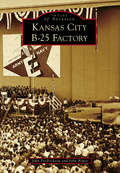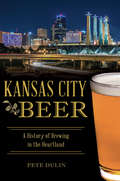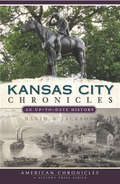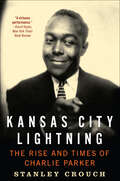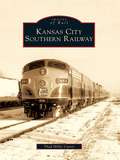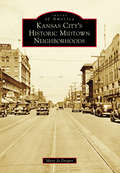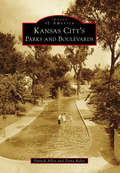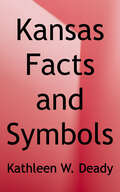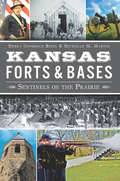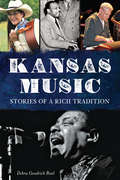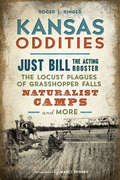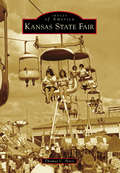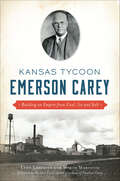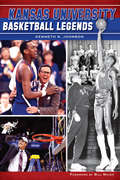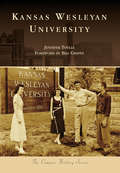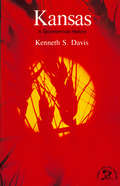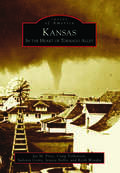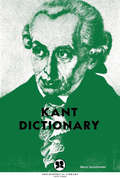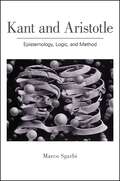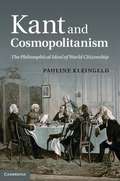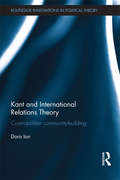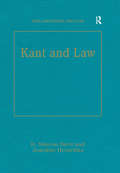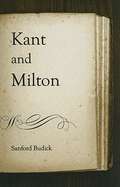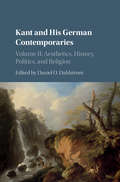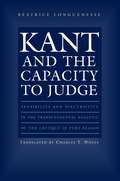- Table View
- List View
Kansas City B-25 Factory (Images of Aviation)
by John Fredrickson John RoperAn industrial miracle took place at the Fairfax Airport, on the shores of the Missouri River, between 1941 and 1945. A massive factory was quickly built and a large modification center was soon added. At its peak, over 24,000 greater Kansas City-area residents were employed by North American Aviation, Inc. Their goal was to build as many twin-engine B-25 Mitchell medium bombers for wartime service as possible. Their success was the construction of an unprecedented 6,608 aircraft. The B-25 Mitchell served with distinction in every theater of World War II, and significant numbers of them were provided to Allied nations. Many B-25s have been preserved, and some of them remain airworthy today. They can be seen on static display or in flight at air shows all across America.
Kansas City Beer: A History of Brewing in the Heartland (American Palate)
by Pete DulinWestbound immigrants, pioneers and entrepreneurs alike arrived in Kansas City with a thirst for progress and beer. Breweries both small and mighty seized opportunity in a climate of ceaseless social change and fierce regional competition. Muehlebach Brewing Company commanded the market, operating in Kansas City for more than eighty years. Built in 1902, the iconic brick warehouse of Imperial Brewing still stands today. Prohibition made times tough for brewers and citizens in the Paris of the Plains, but political "Boss" Tom Pendergast kept the taps running. In 1989, Boulevard Brewing kicked off the local craft beer renaissance, and a bevy of breweries soon formed a flourishing community. Food and beer writer Pete Dulin explores Kansas City's hop-infused history and more than sixty breweries from the frontier era to the twenty-first century.
Kansas City Chronicles: An Up-to-Date History
by David W. JacksonFrom guerilla warfare and martial law to the elegant dresses of the Harzfeld Parisian Cloak Company, discover how everything became up-to-date in Kansas City (including the phrase "up-to-date"? itself, which predates the song in Oklahoma!). Watch as the Jackson County Poor Farm became the state-of-the-art Truman Medical Center and learn why Old Westport is the real McCoy. Meet the resident mouse of the Laugh-O-Gram studio on Thirteenth and Forest, which took food from Walt Disney's hand as Mortimer before taking shape on Disney's drawing board as Mickey. In this collection of his best historical columns, David Jackson delivers a vivid portrait of the people, places and events that continue to shape this fascinating town.
Kansas City Lightning: The Rise and Times of Charlie Parker
by Stanley Crouch“A tour de force . . . Crouch has given us a bone-deep understanding of Parker’s music and the world that produced it. In his pages, Bird still lives.” —Washington PostA stunning portrait of Charlie Parker, one of the most influential musicians of the twentieth century, from Stanley Crouch, one of the foremost authorities on jazz and culture in America.Throughout his life, Charlie Parker personified the tortured American artist: a revolutionary performer who used his alto saxophone to create a new music known as bebop even as he wrestled with a drug addiction that would lead to his death at the age of thirty-four.Drawing on interviews with peers, collaborators, and family members, Stanley Crouch recreates Parker’s childhood; his early days navigating the Kansas City nightlife, inspired by lions like Lester Young and Count Basie; and on to New York, where he began to transcend the music he had mastered. Crouch reveals an ambitious young man torn between music and drugs, between his domineering mother and his impressionable young wife, whose teenage romance with Charlie lies at the bittersweet heart of this story.With the wisdom of a jazz scholar, the cultural insights of an acclaimed social critic, and the narrative skill of a literary novelist, Stanley Crouch illuminates this American master as never before.“A virtuous performance.” —David Hajdu, New York Times Book Review“A magnificent achievement; I could hardly put it down.” —Henry Louis Gates, Jr.“Insightful, profound, and wholly original.” —Wynton Marsalis“A jazz biography that ranks with the very best.” —Booklist, starred review“In prose that veers toward lyrical rapture, [Crouch] conjures the inner life of the improvising artist.” —The New Yorker
Kansas City Southern Railway
by Thad Hillis CarterThe Kansas City Southern Railway initially offered freight service to the immediate Kansas City area south. As the line expanded toward Texas, each tiny community had its own railway station with access to daily passenger service and less-than-carload lot freight services. No one could have foreseen that the road would eventually haul international import and export goods or that its line would reach into Mexico. Photographs in this book include the railway's involvement in operating steam engines over its lines as well as pictures from the files of esteemed rail photographers Harold K. Vollrath and Gary Coates.
Kansas City's Historic Midtown Neighborhoods
by Mary Jo DraperThe unique character of Midtown--from Thirty-first to Fifty-fifth Streets, State Line to the Paseo--grew out of its development as the streetcar suburbs of an expanding Kansas City. As residents both rich and poor moved out of the crowded downtown area after 1880, Midtown neighborhoods were built. The first wave brought mansions to major streets such as Armour Boulevard, Troost Avenue, and Broadway Boulevard, and later a housing shortage spurred the development of Midtown's unique apartment buildings. Well-known architects and local developers created bungalows, shirtwaists, and tree-lined residential streets. Churches and schools, business districts, movie theaters, and other entertainment venues quickly followed residents in their migration to the "south side." By the 1940s, Midtown's growing residential districts had developed into today's popular neighborhoods, including Center City, Coleman Highlands, Countryside, Crestwood, Heart of Westport, Hyde Park, Manheim Park, Old Hyde Park, Plaza-Westport, Rockhill, Volker, Roanoke, South Plaza, Southmoreland, Squier Park, Sunset Hill, Troostwood, Valentine, West Plaza, and Westwood Park.
Kansas City's Parks and Boulevards
by Dona Boley Patrick AlleyA fast-growing frontier community transformed itself into a beautiful urban model of parks and boulevards. In 1893, East Coast newspapers were calling Kansas City "the filthiest in the United States." The drainage of many houses emptied into gullies and cesspools. There was no garbage collection service, and herding livestock through the city was only recently prohibited. Through the diligent efforts of a handful of recently arrived citizens, political, financial, and botanical skills were successfully applied to a nascent parks system. "Squirrel pastures," cliffs and bluffs, ugly ravines, and shanties and slums were turned into a gridiron of green, with chains of parks and boulevards extending in all directions. Wherever the system penetrated well-settled localities, the policy was to provide playgrounds, tennis courts, baseball diamonds, pools, and field houses. By the time the city fathers were finished, Kansas City could boast of 90 miles of boulevards and 2,500 acres of urban parks.
Kansas Facts and Symbols
by Kathleen W. DeadyThis book presents information about the state of Kansas, its nickname, motto, and emblems.
Kansas Forts and Bases: Sentinels on the Prairie
by Debra Goodrich Bisel Michelle M. MartinThe relationship between Kansas and the science of war is ingrained, consistent and evident, yet it seems antithetical to the quiet, conservative farmer who is the quintessential image of the state. It is not. The same values created both, and both created Kansas. From early exploration of America, Bleeding Kansas, the Civil War and the Plains Indian wars to the world wars and the modern era, the forts and bases of the Sunflower State have been central to America's defense. Beginning with Fort de Cavagnial in 1744 through to the defunct fields of Cold War missile silos, historians Debra Goodrich Bisel and Michelle M. Martin provide a guide to the forts and posts throughout Kansas.
Kansas Music: Stories of a Rich Tradition
by Debra Goodrich BiselDespite its sparse population, Kansas is well represented in the annals of music history. The state claims some of the most popular acts from the past century, including Kansas, Count Basie, Big Joe Turner, Martina McBride, Melissa Etheridge and Charlie Parker. A wide variety of genres plays and prospers here, from blues to bluegrass. Beloved venues from mega-festivals like Walnut Valley to jam sessions just off the front porch preserve the state's tuneful heritage. Join Deb Bisel in celebrating this lyrical legacy, from "Home on the Range" to "Dust in the Wind" and beyond.
Kansas Oddities: Just Bill The Acting Rooster, The Locust Plagues Of Grasshopper Falls, Naturalist Camps And More
by Roger L RingerTouch down at Dead Cow International Airport and sample the state's bumper crop of bizarre history. The most commonplace sights contain unlikely stories, from the bulldozer's Morrowsville origins to the sunflower's journey from outlawed weed to state symbol. Some of this heritage lies submerged or buried, like the world's only saltwater spring, which now sits at the bottom of a man-made lake. Rumored caches of the Fleagle Gang's loot still draw treasure hunters in spades. From mariachi legends to rodeo roundups, Roger Ringer gathers in a vast and varied harvest of Kansas lore.
Kansas State Fair
by Thomas C. PercyThe rich history of the Kansas State Fair comes to life in Images of America: Kansas State Fair through photographs from the 1860s to the present. The fair first opened its gates to visitors in 1863 and welcomed all to behold the "Pride of Kansas" until its untimely demise in 1875. In 1913, the Kansas Legislature revived the fair and selected the city of Hutchinson as the exposition's permanent home. Centrally located, Hutchinson has proved an ideal setting. Every year during September, hundreds of thousands of fairgoers flock to the grounds to compete in agricultural or livestock competitions, sell their wares, seek out thrills on the midway amusements, or learn more about the state and its resources. Whatever their motives, all fairgoers leave with a sense of fulfillment.
Kansas Tycoon Emerson Carey: Building an Empire from Coal, Ice and Salt
by Lynn Ledeboer"I've seen a fly make a bull switch his tail" is a homespun quip attributed to Emerson Carey, the powerful salt magnate of Hutchinson, Kansas. True or not, the quote epitomizes the fearless and tenacious character of the legend who became Reno County's benefactor. Young, awestruck Carey arrived in boomtown 1880s Hutchinson and went on to create an immense empire. Coal, ice, salt, strawboard, egg cases, bags, soda ash and streetcars--he presided over it all. From Carey's sleeping in a coal yard with a quarter in his pocket to the founding of the exclusive Willowbrook community and attaining a net worth of more than $15 million, authors Lynn Ledeboer and Myron Marcotte relate the epic story.
Kansas University Basketball Legends (Sports)
by Kenneth N. Johnson Bill MayerThe University of Kansas's men's basketball team is one of the oldest and most successful in the history of college basketball; the very inventor of the sport, Dr. James Naismith, was KU's first coach. Its long and illustrious history began in 1898 and includes some of the biggest names in the game, from legends like Wilt Chamberlain to "secret weapons" like Andrea Hudy, the only female strength and conditioning coach in the division. Longtime Jayhawk enthusiast Kenn Johnson offers up a unique and in-depth look at the players, coaches and other personalities who helped make the University of Kansas basketball program the unparalleled tradition it is today.
Kansas Wesleyan University (Campus History)
by Bill Graves Jennifer ToelleOn September 15, 1886, Kansas Wesleyan University opened its doors for the purpose of higher education. Through strategic plans and successful fundraising campaigns, the campus has grown and evolved remarkably over the past 130 years. The university has employed numerous skilled and passionate faculty members who mentored students toward academic success. As each academic year passes, the school marks notable achievements with pride in areas of academics and athletics as it also stays on the cutting edge of science and technology. Although Kansas Wesleyan has endured struggles, challenges have been promptly met with innovative leadership that laid the groundwork to propel the campus forward, demonstrating perseverance and resilience to craft a lasting legacy. As alumni expand throughout other communities, they carry the university with them. The images within this pictorial history illustrate the university’s institutional history and the enduring Coyote spirit.
Kansas: A History
by Kenneth DavisNo state's creation was more dramatic, more at the center of national attention, more involved in fundamental moral conflict, than that of Kansas. In a sense, the state's history began with the arrival of the first Puritans of New England and the first slaves of Virginia. The States And The Nation Series, of which this volume is a part, is designed to assist the American people in a serious look at the ideals they have espoused and the experiences they have undergone in the history of the nation.
Kansas: In the Heart of Tornado Alley
by Jessica Nellis Craig Torbenson Jay M. Price Sadonia CornsBack in 1915, Snowden D. Flora of the US Weather Bureau wrote, "Kansas has been so commonly considered the tornado state of the country that the term 'Kansas cyclone' has almost become a part of the English language." Flora's words still seem to ring true. Whether called a twister, a tornado, a vortex, or cyclone, these catastrophic events have shaped lives in the Sunflower State for generations. Just a few destructive moments forever changed places such as Irving, Udall, Topeka, Andover, and Greensburg. Even before Dorothy Gale in The Wizard of Oz helped equate the tornado with Kansas, the turbulent nature of local weather seemed to parallel an equally turbulent history, with the fury of people such as John Brown compared to a cyclone. Even if they have never seen a funnel cloud themselves, those who live in Kansas have come to accept the twister as a regular and always unpredictable neighbor.
Kant Dictionary
by Morris StockhammerThe material contained in this dictionary is designed to provide a concise tool of penetration into Kant's system of thought, a system that by virtue of its complexity and linguistic difficulties has long been almost the exclusive property of scholars. Professor Stockhammer has extracted from the vast body of Kant's literature the essential concepts, terms, meanings and definitions of his system, and has arranged them in such a way as to give a clear exposition of Kant's dualistic philosophy. The author, a Viennese Doctor of Philosophy, is one of the eminent Kantians of our time and author of many works in the field. The Kant Dictionary is an extensive collaboration of Kant's philosophy by Morris Stockhammer. Morris Stockhammer is a Professor and a Viennese Doctor of Philosophy. Professor Stockhammer has extracted from the vast body of Kant's literature the essential concepts, terms, meanings and definitions of his system and has arranged them in such a way as to give a clear expositon of Kant's dualistic philosophy.
Kant and Aristotle: Epistemology, Logic, and Method
by Marco SgarbiKant and Aristotle reassesses the prevailing understanding of Kant as an anti-Aristotelian philosopher. Taking epistemology, logic, and methodology to be the key disciplines through which Kant's transcendental philosophy stood as an independent form of philosophy, Marco Sgarbi shows that Kant drew important elements of his logic and metaphysical doctrines from Aristotelian ideas that were absent in other philosophical traditions, such as the distinction of matter and form of knowledge, the division of transcendental logic into analytic and dialectic, the theory of categories and schema, and the methodological issues of the architectonic. Drawing from unpublished documents including lectures, catalogues, academic programs, and the Aristotelian-Scholastic handbooks that were officially adopted at Königsberg University where Kant taught, Sgarbi further demonstrates the historical and philosophical importance of Aristotle and Aristotelianism to these disciplines from the late sixteenth century to the first half of the eighteenth century.
Kant and Cosmopolitanism
by Pauline KleingeldThis is the first comprehensive account of Kant's cosmopolitanism, highlighting its moral, political, legal, economic, cultural and psychological aspects. Contrasting Kant's views with those of his German contemporaries and relating them to current debates, Pauline Kleingeld sheds new light on texts that have been hitherto neglected or underestimated. In clear and carefully argued discussions, she shows that Kant's philosophical cosmopolitanism underwent a radical transformation in the mid 1790s and that the resulting theory is philosophically stronger than is usually thought. Using the work of figures such as Fichte, Cloots, Forster, Hegewisch, Wieland and Novalis, Kleingeld analyses Kant's arguments regarding the relationship between cosmopolitanism and patriotism, the importance of states, the ideal of an international federation, cultural pluralism, race, global economic justice and the psychological feasibility of the cosmopolitan ideal. In doing so, she reveals a broad spectrum of positions in cosmopolitan theory that are relevant to current discussions of cosmopolitanism.
Kant and International Relations Theory: Cosmopolitan Community-building (Routledge Innovations in Political Theory)
by Dora IonThis book challenges popular international relations theories that claim to be based on the political writings of Immanuel Kant, and sheds new light on the philosopher's perspective on peace.Through an analysis of Kant's philosophical work and political traditions of his time, as well as of neglected concepts and theory, this book reappraises modern perspectives on his work. Kant advocated a cosmopolitan community building perspective of peace and international relations that considered issues that are now significant topics of debate such as state sovereignty and unequal access to resources. This book reveals how Kant's political views translate into a vision of international relations that cannot be associated with the democratic and neoliberal theories of peace which until now have claimed Kant's legacy. While the democratic peace theory continues to inspire policy-making, Kant's predictions on war and peace ultimately prove to be most appropriate for the current issues of globalization and diversity.Offering new insights into the meaning of peace and war in international relations, Kant and International Relations Theory is an invaluable resource for students and scholars of international relations and political theory, as well as for those interested in Kant's scholarship.
Kant and Law (Philosophers And Law Ser.)
by B.Sharon ByrdImmanuel Kant's legal philosophy and theory have played an enormous role in the development of law since the eighteenth century. Although this influence can be seen primarily in German law and in the law of nations which have traditionally been oriented toward German legal development, today Kant's philosophy has experienced a Renaissance in the Anglo-American legal world. This anthology collects what the editors believe to be the very best of articles on Kant's legal theory, with an emphasis on his Metaphysics of Morals of 1797. In particular the articles relate to: 1) the nature of law and justice, 2) private law, 3) public law, 4) criminal law, 5) international law, and 6) cosmopolitan law.
Kant and Milton
by Sanford BudickThis book brings to bear new evidence and long-neglected materials to show the importance of Kant's encounter with Milton's poetry to the formation of Kant's moral and aesthetic thought.
Kant and his German Contemporaries: Volume 2, Aesthetics, History, Politics, and Religion
by Daniel O. DahlstromKant's philosophical achievements have long overshadowed those of his German contemporaries, often to the point of concealing his contemporaries' influence upon him. This volume of new essays draws on recent research into the rich complexity of eighteenth-century German thought, examining key figures in the development of aesthetics and art history, the philosophy of history and education, political philosophy, and the philosophy of religion. The essays range over numerous thinkers including Baumgarten, Mendelssohn, Meyer, Winckelmann, Herder, Schiller, Hamann and Fichte, showing how they variously influenced, challenged, and revised Kant's philosophy, at times moving it in novel directions unacceptable to the magister himself. The volume will be valuable for all who are interested in this distinctive period of German philosophy.
Kant and the Capacity to Judge: Sensibility and Discursivity in the Transcendental Analytic of the Critique of Pure Reason
by Béatrice LonguenesseKant claims to have established his table of categories or "pure concepts of the understanding" according to the "guiding thread" provided by logical forms of judgment. By drawing extensively on Kant's logical writings, Béatrice Longuenesse analyzes this controversial claim, and then follows the thread through its continuation in the transcendental deduction of the categories, the transcendental schemata, and the principles of pure understanding. The result is a systematic, persuasive new interpretation of the Critique of Pure Reason. Longuenesse shows that although Kant adopts his inventory of the forms of judgment from logic textbooks of his time, he is nevertheless original in selecting just those forms he holds to be indispensable to our ability to relate representations to objects. Kant gives formal representation to this relation between conceptual thought and its objects by introducing the term "x" into his analysis of logical forms to stand for the object that is "thought under" the concepts that are combined in judgment. This "x" plays no role in Kant's forms of logical inference, but instead plays a role in clarifying the relation between logical forms (forms of concept subordination) and combinations ("syntheses") of perceptual data, necessary for empirical cognition. Considering Kant's logical forms of judgment thus helps illuminate crucial aspects of the Transcendental Analytic as a whole, while revealing the systematic unity between Kant's theory of judgment in the first Critique and his analysis of "merely reflective" (aesthetic and teleological) judgments in the third Critique.
